Deck 12: Infrared Spectroscopy
Question
Question
Question
Question
Question
Question
Question
Question
Question
Question
Question
Question
Question
Question
Question
Question
Question
Question
Question
Question
Question
Question
Question
Question
Question
Question
Question
Question
Question
Question
Question
Question
Question
Question
Question
Question
Question
Question
Question
Question
Question
Question
Question
Question
Question
Question
Question
Question
Question
Question
Question
Question
Question
Question
Question
Question
Question
Question
Question
Question
Question
Question
Question
Question
Question
Question
Question
Question
Question
Question
Question
Question
Question
Question

Unlock Deck
Sign up to unlock the cards in this deck!
Unlock Deck
Unlock Deck
1/74
Play
Full screen (f)
Deck 12: Infrared Spectroscopy
1
Which of the following relationships is not valid as applied to infrared spectroscopy?
A) wavenumber = 1/λ (in cm)
B) ΔE = h ν
C) ΔE = λ ν
D) ν = 4.12 √(K/μ)
A) wavenumber = 1/λ (in cm)
B) ΔE = h ν
C) ΔE = λ ν
D) ν = 4.12 √(K/μ)
ΔE = λ ν
2
Which of the following regions in the electromagnetic spectrum corresponds to the radiation with the highest energy?
A) radio waves
B) ultraviolet
C) infrared
D) visible
A) radio waves
B) ultraviolet
C) infrared
D) visible
ultraviolet
3
Which of the following processes takes place upon absorption of infrared radiation?
A) bond vibration
B) electron excitation
C) nuclear spin flip
D) electron spin flip
A) bond vibration
B) electron excitation
C) nuclear spin flip
D) electron spin flip
bond vibration
4
Which of the following bonds (circled) gives a very weak or no stretching absorption in the infrared spectrum? 
A) 1
B) 2
C) 3
D) 4

A) 1
B) 2
C) 3
D) 4

Unlock Deck
Unlock for access to all 74 flashcards in this deck.
Unlock Deck
k this deck
5
Which of the following laws relates the frequency of a stretching vibration to the masses and spring constant of a simple harmonic oscillator?
A) Pan's law
B) Hooke's law
C) Peter's law
D) Barrie's law
A) Pan's law
B) Hooke's law
C) Peter's law
D) Barrie's law

Unlock Deck
Unlock for access to all 74 flashcards in this deck.
Unlock Deck
k this deck
6
Which of the following carbon-carbon bonds undergoes stretching at the highest frequency?
A) sp3 C − sp3 C
B) alkene sp2 C − sp2 C
C) arene sp2 C − sp2 C
D) C≡C
A) sp3 C − sp3 C
B) alkene sp2 C − sp2 C
C) arene sp2 C − sp2 C
D) C≡C

Unlock Deck
Unlock for access to all 74 flashcards in this deck.
Unlock Deck
k this deck
7
Which of the following bonds gives rise to an absorbance at approximately 2700-3300 cm−1 in the infrared spectrum?
A) C≡C
B) C=O
C) C=C
D) C−H
A) C≡C
B) C=O
C) C=C
D) C−H

Unlock Deck
Unlock for access to all 74 flashcards in this deck.
Unlock Deck
k this deck
8
What range of wavelengths corresponds to the infrared region of the electromagnetic spectrum?
A) 200-400 nm
B) 400-700 nm
C) 2.5-50 μm
D) 2-10 mm
A) 200-400 nm
B) 400-700 nm
C) 2.5-50 μm
D) 2-10 mm

Unlock Deck
Unlock for access to all 74 flashcards in this deck.
Unlock Deck
k this deck
9
Which of the following bonds gives rise to a strong, broad, absorbance at approximately 3200-3650 cm−1 in the infrared spectrum?
A) C=O
B) O−H
C) C=C
D) C−H
A) C=O
B) O−H
C) C=C
D) C−H

Unlock Deck
Unlock for access to all 74 flashcards in this deck.
Unlock Deck
k this deck
10
Which of the following bonds gives the weakest peak in the infrared spectrum for a stretching vibration? 
A) 1
B) 2
C) 3
D) 4

A) 1
B) 2
C) 3
D) 4

Unlock Deck
Unlock for access to all 74 flashcards in this deck.
Unlock Deck
k this deck
11
Which of the following bonds (circled) vibrates at the highest frequency? 
A) 1
B) 2
C) 3
D) 4

A) 1
B) 2
C) 3
D) 4

Unlock Deck
Unlock for access to all 74 flashcards in this deck.
Unlock Deck
k this deck
12
Which of the following bonds undergoes stretching at the highest frequency?
A) C=O
B) C−O
C) C=C
D) C−C
A) C=O
B) C−O
C) C=C
D) C−C

Unlock Deck
Unlock for access to all 74 flashcards in this deck.
Unlock Deck
k this deck
13
Which of the following functional groups is likely to be present in a molecule that has peaks in the infrared spectrum at 1630-1820 cm−1 (strong, broad) and 1000-1250 cm−1; but does not have peaks at 3200-3650 cm−1?
A) alcohol
B) aldehyde or ketone
C) ether
D) ester
A) alcohol
B) aldehyde or ketone
C) ether
D) ester

Unlock Deck
Unlock for access to all 74 flashcards in this deck.
Unlock Deck
k this deck
14
Which of the following bonds (circled) gives the weakest absorbance in the infrared spectrum? 
A) 1
B) 2
C) 3
D) 4

A) 1
B) 2
C) 3
D) 4

Unlock Deck
Unlock for access to all 74 flashcards in this deck.
Unlock Deck
k this deck
15
Which of the following regions in the electromagnetic spectrum corresponds to the radiation with the longest wavelength?
A) radio waves
B) ultraviolet
C) infrared
D) visible
A) radio waves
B) ultraviolet
C) infrared
D) visible

Unlock Deck
Unlock for access to all 74 flashcards in this deck.
Unlock Deck
k this deck
16
What are the units of wavenumber, , in infrared spectroscopy?
A) cm
B) cm?1
C) J?mol?1
D) none, wavenumber is a dimensionless quantity
A) cm
B) cm?1
C) J?mol?1
D) none, wavenumber is a dimensionless quantity

Unlock Deck
Unlock for access to all 74 flashcards in this deck.
Unlock Deck
k this deck
17
Which of the following bonds gives rise to a strong absorbance at approximately 1630-1820 cm−1 in the infrared spectrum?
A) C=O
B) C−O
C) C=C
D) C≡C
A) C=O
B) C−O
C) C=C
D) C≡C

Unlock Deck
Unlock for access to all 74 flashcards in this deck.
Unlock Deck
k this deck
18
Which of the following bonds gives rise to a medium strength absorbance at approximately 1600-1680 cm−1 in the infrared spectrum?
A) C−H
B) C−C
C) C=C
D) C≡C
A) C−H
B) C−C
C) C=C
D) C≡C

Unlock Deck
Unlock for access to all 74 flashcards in this deck.
Unlock Deck
k this deck
19
What is required for a bond to give an infrared absorption?
A) a change in bond length during vibration
B) a change in bond angle during vibration
C) a change in bond dipole during vibration
D) a change in reduced mass during vibration
A) a change in bond length during vibration
B) a change in bond angle during vibration
C) a change in bond dipole during vibration
D) a change in reduced mass during vibration

Unlock Deck
Unlock for access to all 74 flashcards in this deck.
Unlock Deck
k this deck
20
Which of the following bonds undergoes stretching at the highest frequency?
A) O−H
B) C−H
C) C=O
D) C≡C
A) O−H
B) C−H
C) C=O
D) C≡C

Unlock Deck
Unlock for access to all 74 flashcards in this deck.
Unlock Deck
k this deck
21
Which of the following compounds gives an infrared spectrum with peaks at 3300 cm−1 (sharp peak) and 2150 cm−1 (sharp peak)? 
A) 1
B) 2
C) 3
D) 4

A) 1
B) 2
C) 3
D) 4

Unlock Deck
Unlock for access to all 74 flashcards in this deck.
Unlock Deck
k this deck
22
Which of the following functional groups is likely to be present in a molecule that has peaks in the infrared spectrum at 1630-1820 cm−1 (strong, broad), but does not have peaks at 3200-3650 or 1000-1250 cm−1
A) alcohol
B) aldehyde or ketone
C) ether
D) ester
A) alcohol
B) aldehyde or ketone
C) ether
D) ester

Unlock Deck
Unlock for access to all 74 flashcards in this deck.
Unlock Deck
k this deck
23
Which of the following compounds gives a carbonyl bond absorption at the lowest frequency? 
A) 1
B) 2
C) 3
D) 4

A) 1
B) 2
C) 3
D) 4

Unlock Deck
Unlock for access to all 74 flashcards in this deck.
Unlock Deck
k this deck
24
Which of the following compounds gives an infrared spectrum with peaks at 1000-1250 cm−1 (strong), but does not have peaks at 3200-3650 or 1630-1820 cm−1 (sharp, weak peak)? 
A) 1
B) 2
C) 3
D) 4

A) 1
B) 2
C) 3
D) 4

Unlock Deck
Unlock for access to all 74 flashcards in this deck.
Unlock Deck
k this deck
25
The region of the IR spectrum between 1500 - 400 cm-1 would be significantly different for the following two substances? 


Unlock Deck
Unlock for access to all 74 flashcards in this deck.
Unlock Deck
k this deck
26
Assume you are carrying out the conversion of 1-bromobutane to 1-butanol. How could you use IR spectroscopy to determine when the reaction is complete?  As the reaction progress the 3400−3640 cm−1 IR band should increase in intensity.
As the reaction progress the 3400−3640 cm−1 IR band should increase in intensity.
 As the reaction progress the 3400−3640 cm−1 IR band should increase in intensity.
As the reaction progress the 3400−3640 cm−1 IR band should increase in intensity.
Unlock Deck
Unlock for access to all 74 flashcards in this deck.
Unlock Deck
k this deck
27
Which of the following functional groups is likely to be present in a molecule that has peaks in the infrared spectrum at 3200-3650 cm−1 (strong), but does not have peaks at 1630-1820 or 1000-1250 cm−1
A) alcohol
B) aldehyde or ketone
C) ether
D) ester
A) alcohol
B) aldehyde or ketone
C) ether
D) ester

Unlock Deck
Unlock for access to all 74 flashcards in this deck.
Unlock Deck
k this deck
28
Which of the following compounds gives an infrared spectrum with a peak at ∼1750 cm−1, but no significant peaks at 3000-3500 cm−1 or 1050-1250 cm−1? 
A) 1
B) 2
C) 3
D) 4

A) 1
B) 2
C) 3
D) 4

Unlock Deck
Unlock for access to all 74 flashcards in this deck.
Unlock Deck
k this deck
29
Which of the following compounds gives a carbonyl bond absorption at the highest frequency? 
A) 1
B) 2
C) 3
D) 4

A) 1
B) 2
C) 3
D) 4

Unlock Deck
Unlock for access to all 74 flashcards in this deck.
Unlock Deck
k this deck
30
Cyclohexene and 2-hexyne both have the molecular formula C6H10. Any of the following regions of an IR spectrum could be used to distinguish these two compounds.
3020-3100 cm−1
2100-2260 cm−1
1650-1670 cm−1
3020-3100 cm−1
2100-2260 cm−1
1650-1670 cm−1

Unlock Deck
Unlock for access to all 74 flashcards in this deck.
Unlock Deck
k this deck
31
Which of the following compounds gives a carbonyl bond absorption at the highest frequency? 
A) 1
B) 2
C) 3
D) 4

A) 1
B) 2
C) 3
D) 4

Unlock Deck
Unlock for access to all 74 flashcards in this deck.
Unlock Deck
k this deck
32
The area in the infrared spectrum between 1400 and 400 cm-1 is called the functional group region.

Unlock Deck
Unlock for access to all 74 flashcards in this deck.
Unlock Deck
k this deck
33
Which of the following compounds gives an infrared spectrum with peaks in the ranges of 3200-3650 (strong, broad) and 1600-1640 cm−1 (medium); but does not have peaks at 1630-1820 (strong)? 
A) 1
B) 2
C) 3
D) 4

A) 1
B) 2
C) 3
D) 4

Unlock Deck
Unlock for access to all 74 flashcards in this deck.
Unlock Deck
k this deck
34
Which of the following compounds gives an infrared spectrum with peaks at 3000-3500 cm−1 and ∼1750 cm−1? 
A) 1
B) 2
C) 3
D) 4

A) 1
B) 2
C) 3
D) 4

Unlock Deck
Unlock for access to all 74 flashcards in this deck.
Unlock Deck
k this deck
35
Which of the following compounds does not give an infrared spectrum with peak at ∼1750 cm−1? 
A) 1
B) 2
C) 3
D) 4

A) 1
B) 2
C) 3
D) 4

Unlock Deck
Unlock for access to all 74 flashcards in this deck.
Unlock Deck
k this deck
36
Which of the following compounds gives an infrared spectrum with no significant peaks at ∼3300 cm−1 or 1600-1680 cm−1? 
A) 1
B) 2
C) 3
D) 4

A) 1
B) 2
C) 3
D) 4

Unlock Deck
Unlock for access to all 74 flashcards in this deck.
Unlock Deck
k this deck
37
Which of the following functional groups is likely to be present in a molecule that has peaks in the infrared spectrum at 1000-1250 cm−1 (strong), but does not have peaks 3200-3650 at 1630-1820 or cm−1?
A) alcohol
B) aldehyde or ketone
C) ether
D) ester
A) alcohol
B) aldehyde or ketone
C) ether
D) ester

Unlock Deck
Unlock for access to all 74 flashcards in this deck.
Unlock Deck
k this deck
38
Which of the following compounds gives an infrared spectrum with a peak in the range of 1630-1820 cm−1 (strong peak), but does not have peaks at 3200-3650 or 1000-1250 cm−1? 
A) 1
B) 2
C) 3
D) 4

A) 1
B) 2
C) 3
D) 4

Unlock Deck
Unlock for access to all 74 flashcards in this deck.
Unlock Deck
k this deck
39
Which of the following compounds gives an infrared spectrum with peaks in the ranges of 3200-3650 (strong, broad), but does not have peaks at 1630-1820 (strong) or 1600-1640 cm−1 (medium)? 
A) 1
B) 2
C) 3
D) 4

A) 1
B) 2
C) 3
D) 4

Unlock Deck
Unlock for access to all 74 flashcards in this deck.
Unlock Deck
k this deck
40
An IR spectrum of an unknown organic molecule having the formula which contains carbon, hydrogen, and oxygen reveals a strong absorption at 1715-1725 cm-1. This molecule is most likely an ether.

Unlock Deck
Unlock for access to all 74 flashcards in this deck.
Unlock Deck
k this deck
41
The radio wave region of the electromagnetic spectrum would have sufficient energy to produce the following energy transition. 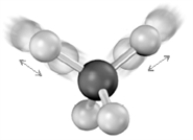


Unlock Deck
Unlock for access to all 74 flashcards in this deck.
Unlock Deck
k this deck
42
Provide the structure of four compounds with the molecular formula C5H10O which give a strong absorption peak at 1700-1740 cm-1 in the infrared spectrum, but no significant peaks at 1600-1640 cm-1 .

Unlock Deck
Unlock for access to all 74 flashcards in this deck.
Unlock Deck
k this deck
43
MATCH a structure from the list below to the following IR spectra. Place the letter of the structure in the blank provided.
_____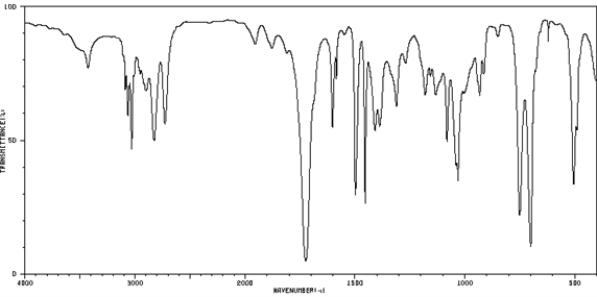 Spectrum obtained from: SDBSWeb: http://www.aist.go.jp/RIODB/SDBS/
Spectrum obtained from: SDBSWeb: http://www.aist.go.jp/RIODB/SDBS/
A)
B)
C)
D)
E)
F)
_____
 Spectrum obtained from: SDBSWeb: http://www.aist.go.jp/RIODB/SDBS/
Spectrum obtained from: SDBSWeb: http://www.aist.go.jp/RIODB/SDBS/A)

B)

C)

D)

E)

F)


Unlock Deck
Unlock for access to all 74 flashcards in this deck.
Unlock Deck
k this deck
44
MATCH each of the following groups of bond-types to the region of the infrared spectrum in which their absorptions occur. Place the letter of the region in the blank to the left of the bond-type.
_____ N−H, C−H, and O−H stretching and bending motions.
A)4000 to 2500 cm−1
B)2500 to 2000 cm−1
C)2000 to 1500 cm−1
D)below 1500 cm−1
_____ N−H, C−H, and O−H stretching and bending motions.
A)4000 to 2500 cm−1
B)2500 to 2000 cm−1
C)2000 to 1500 cm−1
D)below 1500 cm−1

Unlock Deck
Unlock for access to all 74 flashcards in this deck.
Unlock Deck
k this deck
45
he amount of energy in infrared light corresponds to the amount of energy needed to increase certain molecular motions, such as bond vibrations, in organic molecules.

Unlock Deck
Unlock for access to all 74 flashcards in this deck.
Unlock Deck
k this deck
46
MATCH each of the following groups of bond-types to the region of the infrared spectrum in which their absorptions occur. Place the letter of the region in the blank to the left of the bond-type.
_____ triple bond stretching vibrations.
A)4000 to 2500 cm−1
B)2500 to 2000 cm−1
C)2000 to 1500 cm−1
D)below 1500 cm−1
_____ triple bond stretching vibrations.
A)4000 to 2500 cm−1
B)2500 to 2000 cm−1
C)2000 to 1500 cm−1
D)below 1500 cm−1

Unlock Deck
Unlock for access to all 74 flashcards in this deck.
Unlock Deck
k this deck
47
Provide a brief explanation to account for the observation that the frequency of the C=O stretching absorption in the infrared spectrum of 2-butanone is higher than that of 3-buten-2-one.

Unlock Deck
Unlock for access to all 74 flashcards in this deck.
Unlock Deck
k this deck
48
Provide the structure of three compounds with the molecular formula C4H8O that give an absorption peak at 1600-1640 cm-1 in the infrared spectrum, but no significant peaks at 3000-3600 cm-1 or at 1650-1750 cm-1.

Unlock Deck
Unlock for access to all 74 flashcards in this deck.
Unlock Deck
k this deck
49
In terms of the electromagnetic spectrum, 2870 cm−1 represents lower energy than 2.91 × 1016 Hz.

Unlock Deck
Unlock for access to all 74 flashcards in this deck.
Unlock Deck
k this deck
50
MATCH each of the following molecules to the region of the infrared spectrum in which they may show a significant absorption. Place the letter of the region in the blank to the left of the bond-type.
-_______
A)4000 to 2500 cm?1
B)2500 to 2000 cm?1
C)2000 to 1500 cm?1
D)below 1500 cm?1
-_______
A)4000 to 2500 cm?1
B)2500 to 2000 cm?1
C)2000 to 1500 cm?1
D)below 1500 cm?1

Unlock Deck
Unlock for access to all 74 flashcards in this deck.
Unlock Deck
k this deck
51
MATCH a structure from the list below to the following IR spectra. Place the letter of the structure in the blank provided.
_____ Spectrum obtained from: SDBSWeb: http://www.aist.go.jp/RIODB/SDBS/
Spectrum obtained from: SDBSWeb: http://www.aist.go.jp/RIODB/SDBS/
A)
B)
C)
D)
E)
F)
_____
 Spectrum obtained from: SDBSWeb: http://www.aist.go.jp/RIODB/SDBS/
Spectrum obtained from: SDBSWeb: http://www.aist.go.jp/RIODB/SDBS/A)

B)

C)

D)

E)

F)


Unlock Deck
Unlock for access to all 74 flashcards in this deck.
Unlock Deck
k this deck
52
MATCH each of the following molecules to the region of the infrared spectrum in which they may show a significant absorption. Place the letter of the region in the blank to the left of the bond-type.
_______
A)4000 to 2500 cm−1
B)2500 to 2000 cm−1
C)2000 to 1500 cm−1
D)below 1500 cm−1
_______

A)4000 to 2500 cm−1
B)2500 to 2000 cm−1
C)2000 to 1500 cm−1
D)below 1500 cm−1

Unlock Deck
Unlock for access to all 74 flashcards in this deck.
Unlock Deck
k this deck
53
MATCH each of the following molecules to the region of the infrared spectrum in which they may show a significant absorption. Place the letter of the region in the blank to the left of the bond-type.
_______
CH3CH2OCH(CH3)
A)4000 to 2500 cm−1
B)2500 to 2000 cm−1
C)2000 to 1500 cm−1
D)below 1500 cm−1
_______
CH3CH2OCH(CH3)
A)4000 to 2500 cm−1
B)2500 to 2000 cm−1
C)2000 to 1500 cm−1
D)below 1500 cm−1

Unlock Deck
Unlock for access to all 74 flashcards in this deck.
Unlock Deck
k this deck
54
The vertical axis on an IR spectrum represents the percent transmission and the horizontal axis measures frequency (wavenumber).

Unlock Deck
Unlock for access to all 74 flashcards in this deck.
Unlock Deck
k this deck
55
MATCH a structure from the list below to the following IR spectra. Place the letter of the structure in the blank provided.
_____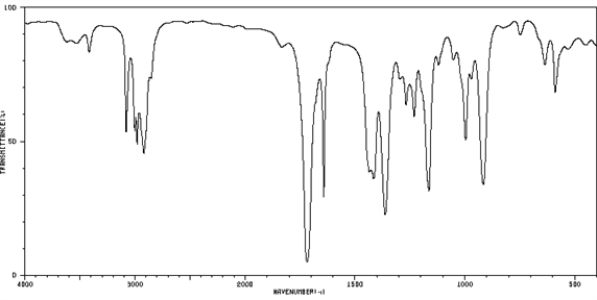 Spectrum obtained from: SDBSWeb: http://www.aist.go.jp/RIODB/SDBS/
Spectrum obtained from: SDBSWeb: http://www.aist.go.jp/RIODB/SDBS/
A)
B)
C)
D)
E)
F)
_____
 Spectrum obtained from: SDBSWeb: http://www.aist.go.jp/RIODB/SDBS/
Spectrum obtained from: SDBSWeb: http://www.aist.go.jp/RIODB/SDBS/A)

B)

C)

D)

E)

F)


Unlock Deck
Unlock for access to all 74 flashcards in this deck.
Unlock Deck
k this deck
56
Provide a brief explanation to account for the observation that 1-butyne gives a significantly stronger peak at ∼1250 cm-1 in the infrared spectrum than 2-butyne..

Unlock Deck
Unlock for access to all 74 flashcards in this deck.
Unlock Deck
k this deck
57
MATCH each of the following groups of bond-types to the region of the infrared spectrum in which their absorptions occur. Place the letter of the region in the blank to the left of the bond-type.
_____ C=O, C=N, and C=C bond absorptions.
A)4000 to 2500 cm−1
B)2500 to 2000 cm−1
C)2000 to 1500 cm−1
D)below 1500 cm−1
_____ C=O, C=N, and C=C bond absorptions.
A)4000 to 2500 cm−1
B)2500 to 2000 cm−1
C)2000 to 1500 cm−1
D)below 1500 cm−1

Unlock Deck
Unlock for access to all 74 flashcards in this deck.
Unlock Deck
k this deck
58
Examining the infrared spectrum of a compound allows us to determine the nature of the conjugated pi electron system in the compound.

Unlock Deck
Unlock for access to all 74 flashcards in this deck.
Unlock Deck
k this deck
59
MATCH each of the following groups of bond-types to the region of the infrared spectrum in which their absorptions occur. Place the letter of the region in the blank to the left of the bond-type.
_____ C−C, C−O, C−N, and C−X single-bond vibrations.
A)4000 to 2500 cm−1
B)2500 to 2000 cm−1
C)2000 to 1500 cm−1
D)below 1500 cm−1
_____ C−C, C−O, C−N, and C−X single-bond vibrations.
A)4000 to 2500 cm−1
B)2500 to 2000 cm−1
C)2000 to 1500 cm−1
D)below 1500 cm−1

Unlock Deck
Unlock for access to all 74 flashcards in this deck.
Unlock Deck
k this deck
60
A C=O bond undergoes stretching at a lower frequency than C=C.

Unlock Deck
Unlock for access to all 74 flashcards in this deck.
Unlock Deck
k this deck
61
What is the energy of a photon moving with a frequency of 10.0 × 1010 s−1? (Planck's constant = 6.626 × 10−34 J s)
A) 6.626 × 10−23 J
B) 6.626 × 10−22 J
C) 66.26 × 10−23 J
D) 66.26 × 10−25 J
A) 6.626 × 10−23 J
B) 6.626 × 10−22 J
C) 66.26 × 10−23 J
D) 66.26 × 10−25 J

Unlock Deck
Unlock for access to all 74 flashcards in this deck.
Unlock Deck
k this deck
62
The given molecule shows a stretching absorption peak at 2200-2250 cm−1 due to the presence of a _____. 
A) nitrile functional group
B) hydroxyl functional group
C) carbon-carbon double bond
D) carbon-carbon single bond

A) nitrile functional group
B) hydroxyl functional group
C) carbon-carbon double bond
D) carbon-carbon single bond

Unlock Deck
Unlock for access to all 74 flashcards in this deck.
Unlock Deck
k this deck
63
How could you distinguish between 1-butanol and diethyl ether by infrared spectroscopy? 


Unlock Deck
Unlock for access to all 74 flashcards in this deck.
Unlock Deck
k this deck
64
Label three peaks in the following spectrum with the bond that gives rise to them, and identify the functional group that is present in the compound (the compound has a formula of C5H10O2)?
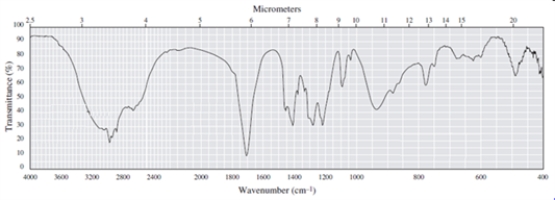


Unlock Deck
Unlock for access to all 74 flashcards in this deck.
Unlock Deck
k this deck
65
What is the frequency of a radiation with a wavelength of 3.0 × 10−5 m? (Speed of light = 3.0 × 108 m/s)
A) 1 × 1013 Hz
B) 2 × 1013 Hz
C) 1.1 × 1013 Hz
D) 1.2 × 1013 Hz
A) 1 × 1013 Hz
B) 2 × 1013 Hz
C) 1.1 × 1013 Hz
D) 1.2 × 1013 Hz

Unlock Deck
Unlock for access to all 74 flashcards in this deck.
Unlock Deck
k this deck
66
How could you distinguish between 1-hexyne and 2-hexyne by infrared spectroscopy? 


Unlock Deck
Unlock for access to all 74 flashcards in this deck.
Unlock Deck
k this deck
67
Why KBr and NaCl are used for sample preparation in the infrared spectroscopic analysis of compounds?

Unlock Deck
Unlock for access to all 74 flashcards in this deck.
Unlock Deck
k this deck
68
The "n" values for ethanol and carbon dioxide are given below. The total numbers of fundamental vibrations observed in ethanol and carbon dioxide are _____ and _____, respectively.
Molecule
CH3CH2OH
CO2
N
5
3
A) 21; 3
B) 21; 4
C) 20; 4
D) 20; 3
Molecule
CH3CH2OH
CO2
N
5
3
A) 21; 3
B) 21; 4
C) 20; 4
D) 20; 3

Unlock Deck
Unlock for access to all 74 flashcards in this deck.
Unlock Deck
k this deck
69
Provide a brief explanation to account for the observation that the frequency of the C=O stretching absorption in the infrared spectrum of N,N-dimethylacetamide, CH3CON(CH3)2, is higher than that of methyl acetate, CH3CO2CH3.

Unlock Deck
Unlock for access to all 74 flashcards in this deck.
Unlock Deck
k this deck
70
How could you distinguish between methyl butanoate and pentanoic acid by infrared spectroscopy? 


Unlock Deck
Unlock for access to all 74 flashcards in this deck.
Unlock Deck
k this deck
71
Label three peaks in the following spectrum with the bond that gives rise to them, and identify the functional group that is present in the compound (the compound has a formula of C6H14O)?
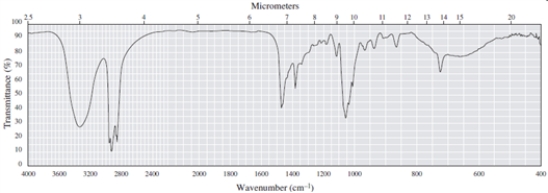


Unlock Deck
Unlock for access to all 74 flashcards in this deck.
Unlock Deck
k this deck
72
The given molecule shows two absorption peaks, each at 1760 cm−1 and 1810 cm−1. The peaks are due to the _____. 
A) symmetric and unsymmetric bending vibrations of the entire anhydride group
B) symmetric stretching vibration of only one carbonyl group
C) unsymmetric stretching vibrations of the carbonyl groups
D) symmetric and unsymmetric stretching vibrations of the entire anhydride group

A) symmetric and unsymmetric bending vibrations of the entire anhydride group
B) symmetric stretching vibration of only one carbonyl group
C) unsymmetric stretching vibrations of the carbonyl groups
D) symmetric and unsymmetric stretching vibrations of the entire anhydride group

Unlock Deck
Unlock for access to all 74 flashcards in this deck.
Unlock Deck
k this deck
73
Label three peaks in the following spectrum with the bond that gives rise to them, and identify the functional group that is present in the compound (the compound has a formula of C4H9NO)?



Unlock Deck
Unlock for access to all 74 flashcards in this deck.
Unlock Deck
k this deck
74
What is the wavenumber of a radiation with a wavelength of 5.0 × 10−5 m?
A) 2.0 × 106 cm−1
B) 2.0 × 104 cm−1
C) 2.1 × 103 cm−1
D) 2.2 × 105 cm−1
A) 2.0 × 106 cm−1
B) 2.0 × 104 cm−1
C) 2.1 × 103 cm−1
D) 2.2 × 105 cm−1

Unlock Deck
Unlock for access to all 74 flashcards in this deck.
Unlock Deck
k this deck



